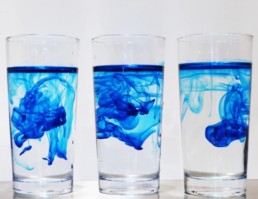
There are eight major players in the world of food allergies: eggs, fish, milk, peanuts, shellfish, soy, tree nuts, and wheat. This group makes up 90 percent of all food allergies, causing everything from rashes to anaphylaxis.
Unfortunately, even if you have escaped sensitivity or full-blown allergies to the items in this group, you aren’t always safe. A wide variety of foods and food additives make up the remaining 10 percent of food allergies,, and they can wreak havoc on your body.
Natural and synthetic food dyes are known trouble-makers, especially among children. Researchers have determined that those with sensitivities and allergies to these dyes may experience any of the symptoms on the allergy spectrum.
Worse still, some reactions don’t fall into standard categories, so it can be difficult to identify the problematic dye and eliminate it from your diet.
Food Dyes and How They May Cause Allergies
The practice of dying food isn’t new. Some natural dyes date back thousands of years, and the first artificial food dye was introduced in the 1800s. However, the phenomenon in which food dye pervades almost every processed product is a recent development.
Processed foods gained popularity in the 1950s, and by 2016, they made up 60 percent of the calories consumed by Americans. The popularity of food dyes rose along with the growth of processed foods, as the dyes became the go-to solution for giving packaged items an appealing appearance.
Food dyes are found in everything from sports drinks to salmon, and they are derived from both natural and artificial sources. When food dyes come from natural sources, those who have allergic symptoms may be responding to the underlying source of the dye.
Artificial dyes, on the other hand, are made from petroleum products. While the US Food and Drug Administration (FDA) has ensured all food additives, including food dyes, are thoroughly tested for safety, many people report sensitivity or allergic reactions to products containing these chemicals.
Blue Food Dye Allergy Symptoms
In the US, most blue coloring comes from Blue No. 1, also known as Brilliant Blue, or Blue No. 2, referred to as Indigo Carmine.
Brilliant Blue is frequently found in foods like canned peas, ice cream, prepared icing, packaged soup, and popsicles. It gives a teal or greenish-blue appearance. Indigo Carmine is more of a royal blue that is regularly used in ice cream, candy, snacks, and children’s cereals. Both of these dyes are synthetic.
If you are allergic to either of these dyes, you might notice itchy skin, hives, flushing, and/or headaches.
More serious reactions include swelling around your lips, swelling of your face, tightness in your throat, chest tightness, rapid heartbeat, wheezing, issues with breathing, low blood pressure, dizziness, and fainting. These may be signs of anaphylaxis, and they require immediate medical attention.
What Happens When You are Allergic to Red Dye?
The two most common red dyes you will find in the United States include Red No. 3, also known as Erythrosine, and Red No. 40, referred to as Allura Red. Erythrosine is particularly bright, so it is used in products like popsicles, candy, and cake-decorating gels.
Allura Red is darker than Erythrosine, and it is one of the most common food colorings you will come across. It can be found in processed foods like candy, cheese, peanut butter crackers, sports drinks, cereals, pickles, marshmallows, salad dressings, and other condiments. Both of these red dyes are synthetic.
Allura Red has sparked quite a bit of controversy, as narrative accounts and some scientific studies have noted a link between this additive and hyperactivity in children. If you are allergic to either of these dyes, you can expect similar symptoms to those listed for blue dye.
Some companies are opting to use natural food dyes in place of Allura Red. These are generally sourced from elderberries, beets, and purple sweet potatoes.
Naturally sourced Red No. 4, known as Carmine, is also a popular coloring. If you have an allergy to the underlying source of the natural dye, you may experience an allergic reaction if you consume foods that rely on these colorants.
Which Yellow Food Dye Causes Allergic Reactions?
Aside from Allura Red, the most common food colorings in the US are Yellow No. 5, referred to as Tartrazine, and Yellow No. 6, also known as Sunset Yellow.
Tartrazine is more of a bright lemon yellow color, while Sunset Yellow has an orange tinge. You can expect to see Tartrazine on ingredient lists for soft drinks, candy, popcorn, chips, and cereals, while Sunset Yellow is more likely to be found in sauces, candy, preserved fruits, and baked goods. Both are synthetic.
The combination of these two yellows and Allura Red make up 90 percent of all food dyes used in the United States. That can be a problem if you have a food dye allergy, because tartrazine is more likely than any of the others to cause an allergic reaction.
While you may experience any of the typical allergy symptoms, Tartrazine is most closely associated with hives and asthma-like breathing difficulties.
There are a number of natural yellow dyes that some companies use in place of Tartrazine and Sunset Yellow. One of the most common, particularly in Mexican and Latin American products, is Annatto. Individuals with peanut allergies appear more likely to have a reaction to Annatto, but fortunately, allergic symptoms tend to be relatively mild.
Foods to Avoid if You Think You Have a Food Dye Allergy
If you determine that your symptoms are being caused by an allergy to food dye, don’t despair.
You may not have to give up your favorite processed treat after all. An allergy to one type of dye doesn’t necessarily mean an allergy to all of them, so try small amounts of foods containing dyes to narrow down the likely culprit.
Some of the foods most likely to contain dyes include the following:
- Baking Mixes
- Candy
- Canned Fruit
- Cereals
- Chips
- Condiments
- Crackers
- Flavored Yogurt
- Frozen Meat
- Frozen Fish
- Fruit Drinks
- Ice Cream and Popsicles
- Jams and Jellies
- Liqueurs
- Processed Cheeses
- Pudding
- Soft Drinks
Note that products marketed to children are particularly likely to contain food dyes, as manufacturers create bright, bold colors to grab children’s attention.
How Long Does Food Dye Take to Leave Your System?
If you do consume a product containing food dye and you have an allergic reaction, the amount of time it takes your body to clear the dye can vary.
The amount you consume plays an important role, along with other factors like how much water you drink.
Most individuals with a food dye allergy notice a decrease in their symptoms within 24 hours, and generally, you can expect all of the effects to clear after two days.
Food Dye Allergy Treatment Options
The bad news is that there is no cure for food dye allergies. The best way to manage this condition is by avoiding foods that contain the dye causing your symptoms.
The good news is that color additives must be listed on food labels, which makes it easier to avoid any food dyes that cause an allergic reaction.
Better yet, you can count on whole foods being dye-free, so you can ensure success by staying away from processed foods as much as possible.
These are some of the foods that are unlikely to contain food dyes:
- Fresh Fish
- Grains
- Oats
- Organic Dairy Products
- Organic Fruit
- Organic Vegetables
- Rice
- Wheat
If you do accidentally consume food dyes and experience an allergic reaction, there are a variety of methods to treat your symptoms. Antihistamines are a good start, particularly if you have hives.
However, if you have severe symptoms such as trouble breathing or anaphylaxis, it is critical to seek medical attention immediately. These reactions can be life-threatening. As with any severe allergy, it may be necessary for you to carry an epinephrine auto-injector to ensure access to immediate treatment for anaphylaxis.
A final note about food dye allergies: many of the colorings used in foods can be found in other products as well. For example, Allura Red is often used in cosmetics, and over-the-counter and prescription medications may contain blue dye. If you have a food dye allergy, you are likely to notice a reaction when the same substance is applied to your skin or consumed as medication. Keep a close eye on ingredient lists for all of the products you use to prevent allergic symptoms.
What’s Next?
About the author

